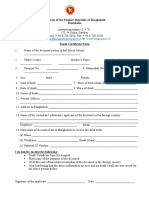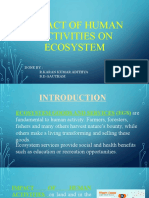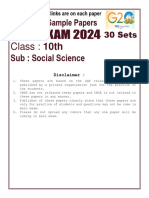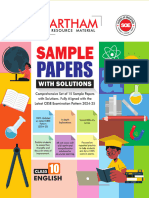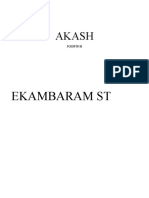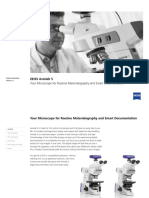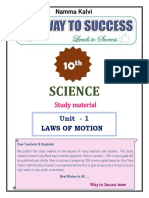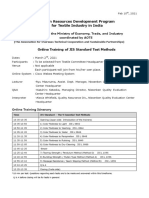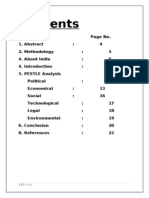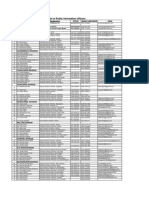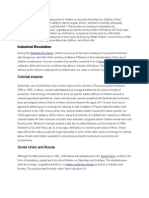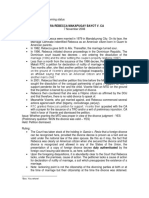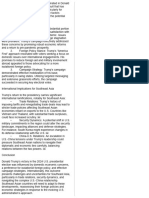CBSE Class 10 History Question Bank
CBSE Class 10 History Question Bank
Uploaded by
basgsrCopyright:
Available Formats
CBSE Class 10 History Question Bank
CBSE Class 10 History Question Bank
Uploaded by
basgsrOriginal Description:
Copyright
Available Formats
Share this document
Did you find this document useful?
Is this content inappropriate?
Copyright:
Available Formats
CBSE Class 10 History Question Bank
CBSE Class 10 History Question Bank
Uploaded by
basgsrCopyright:
Available Formats
Downloaded from www.studiestoday.
com
SOCIAL SCIENCE
QUESTION BANK
STD – X
HISTORY
THE NATIONALIST MOVEMENT IN INDO-CHINA
MCQ (1 MARK QUESTIONS)
1. When did Vietnam get independence ?
(a) 1887 (b) 1945 (c) 1873 (d) 1858
2. Which imperialist power dominated Vietnam ?
(a) French (b) German (c) Russian (d) None of these
3. Which out of the following modern countries comprised the Indo-China ?
(a) India (b) Laos (c) Italy (d) France
4. What was Thailand then called ?
(a) Yunan (b) Mekong (c) Siam (d) None of these
5. What did Paul Bernard think was necessary for the economic development of the colonies ?
(a) Land reforms (b) Increase in cultivation
(c) Curbing population (d) None of thses
6. The colonial economy in Vietnam was primarily based on
(a) Tea plantation (b) Rice cultivation
(c) Cotton production (d) Both (b) and (c)
7. French colonization of Vietnam was based on
(a) Economic exploitation (b) Upliftment and growth
(c) Bringing modern cuviliation (d) None of these
8. Who were the ‘Colons’ ?
(a) Educated Vietnamese (b) Uneducated Vietnamese
(c) Native People of Vietnam (d) French citizens living in Vietnam
9. What did school textbooks in Vietnam proclaim ?
(a) Vietnamese should resist colonization (b) Vietnamese were more educated
(c) French rule could ensure peace in Vietnam (d) Vietnamese should stop working in the fields
10. What kind of education did the Tonkin Free school, in 1907, stress on ?
(a) Learning English Language (b) Looking modern
Downloaded from www.studiestoday.com
Downloaded from www.studiestoday.com
(c) Inculcating western ideas (d) Both (b) and (c)
11. Why did a major protest erupt in the Saigon Native Girls School in 1926 ?
(a) A Vietnamese girl got expelled (b) French students bullied the Vietnamese students
(c) Vietnamese students were only punished (d) Vietnamese were disqualified for white-collar jobs
12. What was the ‘Party of Young Annan ?
(a) Haircutting Charm (b) Students political party
(c) News paper daily (d) None of these
13. What happened to the modern part of Honoi in 1903 ?
(a) Struck by famine (b) Struck by bubonic plague
(c) Struck by smallpox (d) All of these
14. Who was the founder of Hoa Hoa movement ?
(a) Boi Chau (b) Liang Qichao (c) Huynh Phu So (d) Phan Chu Trinh
15. Huynh Phu So’s criticism had a wide appeal against it. Name it.
(a) Child marriage (b) Child abuse (c) Alcohol abuse (d) Useless expenditure
16. Who wrote the History of the Loss of Vietnam ?
(a) Huynh Phu So (b) Phan Boi Chau
(c) Phan Chu (d) None of these
17. When was the long established ;monarchy in China overthrown ?
(a) 1910 (b) 1909 (c) 1911 (d) 1912
18. Who brought together the competing nationalist groups to establish the Vietnamese Community
Party ?
(a) Bao Dai (b) Henry Navarre (c) Ho Chi Minh (d) None of these
19. What was the Ordinance 10 ?
(a) The coup that overthrew Bao’s regime (b) The reason for North and South Vietnam
(c) Communist –led Government (d) Christianity encouraged
Three Marks Questions :
1. Who was Ngyuyen Dinh Chieu ? How did he express his reaction against French Rule over Vietnam ?
2. Explain the rail network programme in Vietnam under French colonial rule.
3. What were the barriers to economic growth in Vietnam as suggested by Bernard.
4. Define civilizing Mission ? Where was it adopted by the French in Vietnam ?
5. Why did colons oppose the policies that would given the Vietnamsese full access to French
education ?
Downloaded from www.studiestoday.com
Downloaded from www.studiestoday.com
6. Explain the nature of school text books in Vietnam under colonial rule.
7. Since the establishment of French rule the Vietnamese peasant no longer lives in constant terror of
pirates. .. Calm is complete and peasant can work with good heart”. In which context it is said ?
8. What did the French adopt to improve the Vietnamese to look modern ?
9. Name the political party formed by the Vietnamese students and name the Journal published by the
Vietnamese students.
10. How did the Vietnamese teachers show silent resistance in the school ?
11. Explain how the hygienic environment in the French part of Hanoi became the cause of plague.
12. Define syncetic tradition.
13. How did the Vietnameses nationalists interpret the vision of modernization ?
14. Explain the objectives of the Vietnamese students those who went to Japan.
15. How did the developments in China in 1911 change the objective of the Vietnamese nationalists?
16. Under which circumstances the uprising took place in Ha Tinh and Nghe An ? how was it suppressed
by the French ?
17. What is Viet Minh ? Why was it formed ? What role did it play in anti-imperialist struggle ?
18. State the significance of war between Vietnam and France during 1946-1954.
19. Explain the impact of the division of Vetnam?
20. Under which circumstances civil war broke out in Vetnam ?
21. Explain the steps taken by Ngo Dinh Diem to establish authoritarian government in South Vietnam.
22. Explain the weapons used by the USA in the Vietnamese war.
23. What was the attitude of USA policy planners towards the Vietnamese war ?
24. How did the writers and political thinkers represent the nature of women in Vietnam ? Explain with
examples.
25. State the significance of Generva Conference.
26. How did the scholar Noam Chimsky Visualise Vietnam war ?
27. State the significance of Ho Chi Minh Trail
28. Why did only one third of the students in Vietnam pass the school leaving examinations ?
29. Describe the ideas behind the Tonkin Free School. To what extent was it a typical example of
colonial ideas in Vietnam ?
30. Explain the influence of China on Vietnam’s culture and life.
Five Marks Questions:
1. Explain the steps taken by France in Mekong delta to improve cultivations.
2. Explain why the French thought colonies necessary.
3. Who was Paul Bernard ? Explain the argument given by Bernard regarding the development of
Vietnam.
4. Explain the nature of colonial economy in Vietnam.
5. In order to educate the Vietnamese, the French had to resolve a dilemma. How ? Explain.
6. Explain two broad opinions of French policy makers on the question of language policy in
Vietnamese schools.
7. Explain the nature of colonial education in Vietnam.
Downloaded from www.studiestoday.com
Downloaded from www.studiestoday.com
8. Explain the evests of major protest erupted in the Saigon Native Girls School.
9. How did the battle against French colonial education become part of the larger battle against the
colonialism and for independence.
10. Schools thus became on important place for political and cultural battles. How ? Explain
11. The actions of rat-catchers tell us of the numerons small ways in which colonialism was fought in
everyday life. How explain.
12. Under which circumstances rat hunt programme started in Hanoi ? Was it successful ?
How did the Vietnamse show colonial resistance through rat hunt programme ?
13. Explain the nature and significance of the scholar Revolt and Hoa Hao movement.
14. How did Huynh Phu so contribute to the anti-colonial resistance.
15. Explain two groups of opinions and views regarding the modernization of Veitnam.
16. How did Phan Boi Chu and Phan Chu Trinh contribute to anti imperialist struggle in Vietnam ?
17. How did japan and China influence the moderanisation of Vietnam ?
18. What ideas did Phan Boi Chu and Phan Chu Trinh share in common ? What did they differ on ?
19. Explain the impact of Great Depression of Vietnam.
20. Describe giving examples reactions of the Vietnames people to French colonialism.
21. Under which circumstances the Democratic Republic of Vietnam was formed? How did HO Chi Minh
contribute to its success ?
22. Explain the challenges faced by the republic Vietnam under Ho Chi Minh.
23. Under which circumstances USA entered into the Vietnam war ?
24. Explain the impact of Vietnamese war on USA with special reference to USA people, USA media and
film and USA Policy planners.
25. Define the HO Chi Minh Trail. Explain its role in the Vietnam war.
26. Explain the role of women in Vietnam as warriors and workers in peace time.
27. Under which circumstances USA withdrew from the war ?
28. Explain the events leading to the unification of Vietnam.
29. Discuss the steps taken by French Government to dismantle Chinese influence on Vietnam.
30. How did the French contribute to the making of Vietnam as the third largest producer of rice in the
world ?
31. What steps did the French take to modernize the Vietnameses ?
32. The rat menace marks the limits of French power and contradictions in their civilizing mission.
Justify the statement.
33. State the lesson learnt by the Vietnamese form the 1903 plague.
34. Give a brief account of paul Bernard’s views on relationship between colonies and colonizers with
reference to Vietnam.
35. What does the 1903 plague and the measures to control it tell us about the French colonial attitude
towards the questions of health and hygine ?
36. The Vietnamese used their limited resources to great advantage Explain.
37. Rats were must common in the modern, newly built areas of Honoi. Why ? Explain
38. How nationalism in Vietnam emerged through the efforts of different sections of the society to fight
against the French. Explain with 3 suitable points.
Downloaded from www.studiestoday.com
Downloaded from www.studiestoday.com
39. Religion played on important role in strengthening colonial control over France. Religion also
provided ways of resistance against colonial regulation. Explain.
40. State the lesson learnt by the Vietnamese from the 1903 plague.
41. Give a brief account of paul Bernard’s views on relationship between colonies and colonizers with
reference to Vietnam.
42. What does the 1903 plague and the measures to control it tell us about the French colonial attitude
towards the questions of health and hygine ?
43. The Vietnamese used their limited resources to great advantage. Explain
44. Rats were must common in the modern, newly built areas of Honoi, Why ? Explain
45. How nationalism in Vietnam emerged through the efforts of different sections of the society to fight
against the French. Explain with 3 suitable points.
46. Religion played on important role in strengthening colonial control over France. Regional also
provided ways of resistance against colonial regulation. Explain
47. Why do some historians consider Vietnamese civil war more brutal than the 2nd World War ?
48. Why did the French develop infrastructure in Vietnam ?
49. Why did writers like PAUL Bernard believe in developing the economy of the colonies ?
50. Why were the colonizers interested in exploring and mapping rivers in their colonies ?
51. The government made the Saigon Native Girls School take back the students it had expelled.”
Explain.
52. How did the students contribute to national movement in Vietnam ?
53. “Education was one of the spheres of everyday life in which political battle against colonialism was
fought.” Explain
54. How did the Vietnamese differ on the question of modernization and nationalism ?
55. How was the second phase of the nationalist movement different from the first phase ?
56. Did the Declaration of independence, 1945, mean that Vietnam had become a free sovereign nation
?
57. Did the French introduce education in Vietnam as a “civilizing mission”?
58. Why did the dictatorship of Ngo Dinh diem become unpopular ?
Value Based Questions: (3 to 5 marks)
59. How can you say that the Vietnamese used education as a weapon to fight against colonialism?
60. What moral lesson you have learnt from Vietnam civil war?
61. What is your opinion on the civilizing mission of the French? Do you agree with the civilizing mission
of the French in Vietnam? Justify your answer.
62. Who was Huynh Phu so? Explain his role as a Social reformer.
63. Who was Phan Chu Trinh? What moral values you can learn from his philosophy or life?
64. What moral values the anti – imperialist struggle in Vietnam teaches you?
Downloaded from www.studiestoday.com
Downloaded from www.studiestoday.com
Nationalism in India
MCQ (1 MARK QUESTIONS)
1. The idea of Satyagraha emphasized ____________
a) The power of truth and the need to search for truth.
b) The power of mass agitation and the need to search for truth.
c) The power of truth and the need to search for God.
d) The power of people and the need to search for truth.
2. In which city Mahatma Gandhi launched Satyagraha in 1916?
a) Amritsar b) Kheda c) Ahmedabad d) Champ ran
3. In which city Mahatma Gandhi launched Satyagraha in 1918?
b) Amritsar b) Kheda c) Ahmadabad d) Champ ran
4. The kheda Satyagraha was launched by Gandhiji to support _________
a) The mill workers b) The peasants
c) The women workers d) Rowlatt Act
5. The Jallianawala Bagh incident took place on ________
a) 13th April, 1920 b) 13th April, 1921 c) 13th April, 1922 d) 13th April, 1919
6. The Non – Co-operation – Khilafat movement began in ____________
a) March 1921 b) February 1921 c) January 1921 d) December 1921
7. “The Non-Cooperation – Khilafat Movement in the cities gradually slowed down.” Which of the
following is an appropriate reason for the same?
a) Khadi cloth was expensive.
b) The people boycotted the government instrituitons but there were no alternative Indian
institutions.
c) The Muslim community did not participate the movement.
d) Gandhiji refused to cooperate with the people.
a) Only (i) and (ii)
b) Only (ii) and (iii)
c) Only (iii) and (iv)
d) All of the above
8. In the countryside the Non – cooperation Movement was against the _____________
a) Gomasthas b) Talukdars c) Police d) Village Headman.
9. What was the Inland Emigration Act of 1859?
a) Under this Act plantation workers were not permitted to leave the tea gardens without
permission.
b) Under this Act Indians were not allowed to migrate to other countries.
c) Under this Act the British were not allowed to leave India.
d) Under this adivasis were not allowed to leave the forests.
Downloaded from www.studiestoday.com
Downloaded from www.studiestoday.com
10. When was Non – Cooperation movement called off by Gandhiji?
a) 1920 b) 1921 c) 1922 d) 1923
11. Why was the Non – Cooperation movement called off by Gandhiji?
a) Due to Chauri Chaura violent incident
b) Due to protest against British empire
c) Because Muslims did not participate in the movement.
d) Because Christians did not participate in the movement
12. Who among the following were associated with the Swaraj Party?
a) C.R. Das and Mahatma Gandhi
b) Mahatma Gandhi and Jawaharlal Nehru
c) C.R. Das and Motilal Nehru
d) Motilal Nehru and Jawaharlal Nehru
13. When the Simon Commission arrived in India in _______________, it was greeted with the slogan
____________.
a) 1927, Go Back Simon b) 1928, Go Back Simon
c) 1929, Go Back Simon d) 1930, Go Back Simon
14. Who announced a vague offer of “Dominion Status” for India in 1929?
a) Lord Curzon b) Viceroy Irwin c) Lord William Bentinck
d)Lord Mountbatten
15. On 31st January, 1930 Gandhiji sent a letter to _______ stating his eleven demands.
a) Lord Curzon b) Lord Mountbatten
b) c) Viceroy Irwin d)Lord William Bentinck
16. Mahatma Gandhi started his famous salt march from his ashram in ____________ to the Gujarati
coastal town of ________.
a) Sabarmati, Kheda b) Sabarmati, Dandi c) DFandi, Sabarmati
d)Kheda, Sabarmati
17. Which incident marked the beginning of the Civil Disobedience Movement?
a) When Gandhiji started from his ashram.
b) When Gandhiji violated the Salt Act.
c) When Gandhiji wrote to Lord Irvin.
d) When Gandhiji left the Congress.
18. Which pact was signed in 1981 through which Gandhiji decided to call off the Civil Obedience
Movement?
a) Gandhiji – Curzon Pact b) Curzon – Nehru Pact c) Gandhi – Irwin
Pact
d)Gandhi – Mountbatten Pact.
19. Under the Gandhi – Irwin Pact Ganhdiji _________.
a) Decided to call off the Civil Disobedience Movemengt.
Downloaded from www.studiestoday.com
Downloaded from www.studiestoday.com
b) Decided to cooperate with the Muslims.
c) Decided not to violate Salt Act.
d) Decided not to launch the Swadeshi Movement.
20. In the countryside, rich peasants and Jats of Uttar Pradesh actively participated in the Civil
Disobedience Movement because ___________
a) They wanted Purna Swaraj.
b) They were hard hit by the trade depression and falling prices.
c) The government was changing their religion.
d) The government was forcing land ceiling.
21. “The relationship between the poor peasants and the Congress remained uncertain during the Civil
Disobedience Movement.” Which of the following is appropriate reason for the same?
a) The poor peasants were interested in the lowering of the revenue demand.
b) They wanted the unpaid rent to the landlord to be remitted.
c) They launched a no rent campaign
d) They were hard hit by the depression.
a) Only (i) and (ii)
b) Only (ii) and (iii)
c) Only (iii) and (iv)
d) All of the above
22. Most businessmen of India came to see Swaraj ____________.
a) When colonial restrictions on business would no longer exist and trade industry would flourish
without constraints.
b) When India will get its independence.
c) When all people are free.
d) None of the above.
23. Who said, “The Swaraj would not come for a hundred years if untouchability is not eliminated.”
a) Motilal Nehru b) Subhas Chandra Bose c) Mahatma Gandhi d) Annie Besant
24. Who organized the Dalits into the Depressed Classes Association?
a) B.R. Ambedkar b) Mahatama Gandhi c) Motilal Nehru d) jawarharlal Nehru
25. Who created the first image of Bharat Mata?
a) Bankim Vhandra Chattopadhyay b) Subhas Chandra Bose
b) Rabindra nath Tagore d) Rahja Ravi Verma
26. Abanindranath Tagore was a / an _____________.
a) Scientist b) Painter c) Economist d) Political Leader
27. The Folklore of southern India was written by ____________.
a) Abanindranath Tagore b) Rabindranath Tagore
b) Raja Ravi Verma d) Natesa Sastri
Downloaded from www.studiestoday.com
Downloaded from www.studiestoday.com
28. During the Swadeshi Movement in Bengal, a tricolor flag was designed. It had eight lotuses that
represented _____________.
a) Religions b) Provinces of British India
c) Kings of India d) National Symbols of India
29. ___________ was responsible for the Jallianwala Bagh incident.
a) Lord Curzon b) Lord Irwin c) General Dyer d) Lord Mountbatten
30. Match the following:
a) 1919 1. Launching of Civil Disobedience Movement
b) 1922 2. The Lahore Session of the Congress
c) 1929 3. Chauri – Chaura incident
d) 1930 4. Jallianwalabagh Incident
A B C D
a) 1 2 3 4
b) 2 3 4 2
c) 3 4 1 2
d) 4 3 2 1
31. Who among the following was the author, of the famous novel” Anandmath”?
a) Bankim Chandra Chattopadhyay b) Abanindranath Tagore
b) Natesa Sastri d) Rabindranath Tagore
32. The resolution of Poorna Swaraj was adopted at which Session of the Congress?
a) Karachi b) Haripur c) Lahore d) Lucknow
33. Who led the peasant movement in Oudh during the Non – Co-operation Movement?
a) Motilal Nehru b) Mahatma Gandhi c) Baba Ramchandra d) Sardar Patel
34. The Simon Commission was boycotted in India because:
a) There was no India member in the Commission.
b) It supported the Muslim League.
c) Congress felt that people deserved Swaraj.
d) There were differences among the members.
35. Which was the main cause for boycotting foreign goods during Non – co-operation Movement?
a) A Symbol of western economic and cultural dominations.
b) A symbol of foreign rule.
c) A Symbol of western political domination.
d) A Symbol of oppressive rule.
36. Which pact resolved the issue of separate electorates for Dalits between Gandhi and Ambedkar in
1932?
a) Lucknow pact b) Nagpur pact c) Poona pact d) Surat pact.
37. Baba Ramchandra was associated with which event?
Downloaded from www.studiestoday.com
Downloaded from www.studiestoday.com
a) Khilafat Movement b) Champaran satyagraha
c) Oudh Peasant struggle d) Kheda Peasant Satyagraha
38. In which city jallianwalabagh incident took place?
a) Amritsar b) Ambala c) jalandhar d) Meerut
39. Which of the following was the reason for Indian Opposition to the Rowlatt Act (1919)
a) It was passed hurriedly.
b) It gave the govt. enormous power.
c) Local leaders were picked up.
d) It authorized the govt. to imprison political prisoners without trial.
40. Champaran Satyagraha (1916) was launched by Gandhiji against
a) High Revenue Demands b) Racial Discrimination
c) Textile Mill Owners d) Repressive Planatation System
41. Which among the following was the emergence of Modern nationalism in India?
a) New Symbols b) Icons c) New Ideas d) Anti-Colonial Movement.
42. The Congress Session of 1929 was presided over by
a) Mahatma Gandhi b) Jawaharlal Nehru c) C.R. Das d) Subhas Chandra Bose
43. Which of the following is true about the provision of Gandhi – Irwin pact
a) Gandhi agreed to attend First Round Table Conference
b) Gandhi agreed to attend 2nd Round Table Conference
c) Grant of Complete Independence
d) Political prisoners were arrested.
44. Which of the following is true about G.D. Birla?
a) A freedom fighter b) A prominent Industrialists c) A worker d) A land Lord
3 MARKS QUESTIONS:
1. How was the growth of modern nationalism connected to the anti-colonial movement?
2. When did Jallianwallahbagh incident take place? Were the people aware about the imposition of
martial law in Amritsar?
3. What was the objective of the Khilafat movement? Why did Ali Brothers support Gandhiji?
4. State the importance of congress session held at Calcutta and Nagpur in 1920.
5. What did Gandhiji declare in his famous book Hind Swaraj?
6. Gandhiji proposed that the Non – Cooperation movement should unfold in stages. Explain three
stages.
7. Explain the reasons for which the Non Cooperation Movement gradually slowed down in the towns
and cities.
8. Why did Gandhiji suspend the Non Cooperation Movement?
Downloaded from www.studiestoday.com
Downloaded from www.studiestoday.com
9. Name two younger leaders during 1920s. What did they press?
10. Under which circumstances Swaraj party was formed?
11. How did Indians react to the appointment of Simon Commission?
12. State the importance of eleven demands made by Gandhiji in a letter to the Viceroy Lord Irwin.
13. State the provisions of Gandhiji Irwin Pact.
14. Explain second Round Table Conference.
15. When and why did Gandhiji relaunch Civil Disobedience Movement?
16. What was the attitude of the poor peasants toward the Civil Disobedience Movement?
17. Explain Gandhiji’s idea regarding the duty of women in the society.
18. What steps did the nationalist take to revive Indian Folklore?
19. What impact did the reinterpretation of Indian History put on the minds of Indian people?
20. Why were Indians were outraged by the Rowlatt Act?
21. Why was congress leadership unhappy with the form that developed by the Awadh peasant
movement?
22. British rule was detrimental to the interest of Indian People. Explain it by giving 3 suitable examples.
23. Describe the reaction of the Congress leaders to Lord Irwin’s proposal in October 1929.
24. Why was congress reluctant to include workers’ demands as part of its programme of struggle?
25. State three important features of Civil Disobedience Movement.
26. State three important features of Non Cooperation Movement.
27. Following the launch of the Non Cooperation Movement in January 1921, Council elections were
boycotted in most provinces. Which party did not boycott council elections. Why? Give reasons.
28. Why many of the social groups who in earlier phase of the Civil Disobedience Movement were
enthusiastic supporters, became lukewarm on the relaunch of the Civil Disobedience Movement
(1932). Give reasons.
29. Critically examine 3 different ways adopted by different leaders to forge different social groups
together within one movement to fight against British rule in India.
30. Why did Gandhiji call off anti – Rowlatt Satyagraha? State one short coming of this movement.
31. What was the impact of Great depression on India?
32. Who was Khan Abdul Gaffer Khan? How did the people react to his arrest?
33. What role did the communists and Socialists have in organizing the poor peasantry? Why was
congress unwilling to support the no rent campaign of the poor peasants?
34. State the nature of the national movement in the years after 1919.
Nationalism in India: (5 marks)
35. Describe new methods of mass agitation started by Gandhiji.
36. How did First World War bring hardship upon India people?
37. Explain the effects of Non – Cooperation Movement on economic front in the towns.
38. How did the Non Cooperation Movement influence the plantation workers in Assam? What was the
notion of Swaraj for them.
Downloaded from www.studiestoday.com
Downloaded from www.studiestoday.com
39. How did the Congress and Tribals interpret the visions of the Non Cooperation Movement?
40. Why did Gandhiji choose to break salt law? State the developments that preceded the Dandi March.
41. State the difference between Civil Disobedience Movement and Non Cooperation Movement.
42. What methods were adopted during Civil Disobedience Movement?
43. Explain the progress of Civil Disobedience Movement in Peshwar, Sholapur.
44. Why did Gandhiji start Civil Disobedience Movement?
45. How were the peasant communities of Gujrat and UP influence by the Civil Disobedience
Movement. Why were they deeply disappointed when the movement was called off in 1931.
46. How did Business classes interpret Swaraj? Why were business groups not uniformly enthusiastic
towards Civil Disobedience Movement after the failure of 2nd Round Table Conference?
47. What was the attitude of the Industrial working class towards the Civil Disobedience Movement?
48. Explain the role of women in the Civil Disobedience Movement.
49. The participation of Dalit in the Civil Disobedience movement was limited. Why? Explain.
50. What was the attitude of Gandhiji towards depressed classes?
51. Under which circumstances a negotiation took place between Gandhiji and the depressed classes.
52. Explain the congress activities immediately after the suspension of the Non – Cooperation
Movement.
53. Compare the image of Bharat Mata and the image of Germania.
54. Why did political leaders differ sharply over the question of separate Electorate.
55. Analyse the circumstance which led Gandhiji to start Non Cooperation Movemnet?
56. In what ways the British rule in India was oppressive?
57. Explain the immediate effects of the Lahore Cogress Session in the Indian National Movement .
58. Explain with 2 examples how Gandhiji used satyagraha as a weapon against the Britishers. Why was
khilafat Movement launched?
59. Was Gandhiji justified to launch a nationa wide Satyagraha against the proposed Rawlatt Act 1919?
60. How could Non Cooperation become a movement?
61. How did different social groups conceive of the idea of Non cooperation Movement?
62. Who participated in the Non Cooperation Movement?
63. How did the middle class in the towns respond to the Non cooperation movement?
64. What role did Baba Ramchandra play in the Non cooperation movement?
65. How did the Awadh peasants, Gudem Hills tribal peasants and plantation workers respond to
Gandhiji’s call for Swaraj.
66. How did the NCM turn violent in many places? Give 3 examples.
67. How was the opinion of Nehru and Subhas Ch. Bose different from the Swaraj party?
68. Some icons and symbols were used for unifying the people and inspiring with them the feeling of
nationalism. Give 2 evidences in support your answer.
69. Why did Dr. B.R. Ambedkar clash with Mahatma Gandhi at the Second Round Table Conference?
How was it ended?
70. How was Poona Pact helpful to strengthen the process of integration in Indian Society?
71. Is the Satyagraha a weapon of the weak? What did Gandhiji mean when ha said Satyagraha is active
resistance?
Downloaded from www.studiestoday.com
Downloaded from www.studiestoday.com
72. State the inalienable right of the Indian people expressed through the Independence Day pledge
1930.
73. Civil Disobedience Movement failed to attract all. Justify the statement.
74. How was the slogan of Purna Swaraj different from the slogan of Swaraj? When and where was the
resolution for complete Independence passed?
75. Why did Indian National Congress change its goal from Swaraj to complete Independence?
76. Critically examine different ways suggested by different leaders for uplifting the status of dalits in
Indian society.
77. Explain the progress of Civil Disobedience Movement in the towns.
78. How did the peasants in countryside respond to the Civil Disobdience Movement?
79. How did the business classes, Indian merchants and Industrialists relate to the Civil Disobedience
Movement?
80. Not all social groups were moved by the abstract concept of swaraj.Justify it by giving suitable
points.
81. Explain the condition of plantation workers and tribal peasants during colonial rule.
82. Explain the idea of Satyagraha.
82. Explain Gandhiji’s satyagraha Movements during 1916 – 1918.
83. 108. Explain the main feature of Nationalist Movement during the period 1919 – 1922.
84. How did different social group interpret Swaraj?
85. State the historic significance of Dandi March 1930. Explain the developments that succeeded the
Dandi March.
86. Explain the participation of different social groups in the Civil Disobedience Movement.
87. The identity of India is most often symbolized in a figure or image. How? Explain with suitable
examples.
88. Explain the factors responsible for strengthening the sense of collective Belongingness.
89. Salt March was an effective symbol of colonial resistance. Justify.
90. Explain the hopes and struggles of different social groups to join Non cooperation Movement.
91. What was the outcome of Poona Pact? How did it benefits the Dalits?
92. Critically examine the main aspects of Indian National Movement during the period between
1920 – 1930.
93. The Non – cooperation Movement was the first mass based political agitation. Justify by giving four
suitable examples.
94. Give four significant chartacteristics of modern nationalism that came into existence in Europe.
95. “Congress had a remarkable role in uniting various social groups for a common cause of national
freedom”. Explain with four points.
VALUE BASED QUESTIONS:
1. Explain the factors which were responsible for promoting spirit of nationalism
2. How did Gandhiji try to integrate the depressed classes into society?
3. What moral values are reflected by Satyagraha?
Downloaded from www.studiestoday.com
Downloaded from www.studiestoday.com
4. Explain the role of women in the Civil Disobedience Movement.
5. Why for a long time the congress had ignored the dalits? What role did Gandhiji play in uplifting
them? What moral values you have learnt from Gandhiji’ s behavior towards dalits?
6. Mention the major factors which promoted the sense of nationalism in India by 19th century. Do you
think these factors still help in promoting the spirit of nationalism?
7. Prove, giving evidences that India was emerging as a nation with voices wanting freedom from
colonial rule.
LIST OF MAP ITEMS:
Outline Political Map of India
For locating and labeling/Identification.
1. Indian National Congress sessions: Calcutta 1920, Nagpur 1920, Madras 1927, Lahore 1929
2. Important centers of Indian National Movement (Non Cooperation and Civil Disobedience
Movement)
i) Chauri Chaura (UP) suspension of Non Cooperation Movement
ii) Bordoli (Gujrat) no tax campaign
iii) Dandi Gujrat Civil Disobedience Movement
iv) Champaran (Bihar) Movement of indigo Planters.
v) Amritsar (Punjab) Jallianwalla Bagh Movement
vi) Kheda (Gujrat) Peasant Satyagraha
vii) Ahmedabad (Gujrat) Cotton Mill Workers Satyagraha
CONTEMPORARY INDIA II (GEOGRAPHY)
CLASS X
MINERALS AND ENERGY RESOURCES
Multiple choice questions:
45. Which of the following are not fossil fuels?
a)Biogas b) Coal
b)Natural Gas d) Petroleum
46. Mineral Oil are found in
a) Placer deposit b) Sedimentary rock
b) c) Igneous rock d) Metamorphic rock
47. Which mine is known as 100 percent export unit?
a) Chitradurga b) Tumkur
c) Kudermukh d) Bellary
Downloaded from www.studiestoday.com
Downloaded from www.studiestoday.com
48. The Balaghat mines of manganese located in
a) Madhya Pradesh b) Andhra Pradesh
c) Jharkhand d) Odisha
49. The first hydroelectric plant was installed in
a) Shiva Samundram b) Bombay
c) Kanpur d) Nainital
50. Which state has the largest deposit of coal in India?
a) Jharkhand b) Madhya Pradesh
c) West Bengal d) Chhatisgarh
51. Which mineral is formed as a result of evaporation in desert region
a) Gypsum b) Bauxite
c) Coal d) Iron ore
52. In India, Geothermal energy is generated at
a) Madhepur near Bhuj b) Gulf of Kachchh
c)Manikaran in Himachal Pradesh d) Nagercoil
9. How much percentage of Bauxite is produced in Odisha?
a) 13% b) 14%
c) 17% d) 45%
10. Kochi Oil refinery is located in
a) Gujrat b) Odisha
c) Kerala d) Chhatisgarh
11. Minerals found in placer deposit
a) Gold b) Iron
c) Copper d) Bauxite
12. Nellore mica belt is located in which state
a) Maharastra b) Chhatisgarh
c) Andhra Pradesh d) karnataka
13. The Oldest Oil producing state of India
a) Gujrat b) Assam
c) Maharastra d) Arunachal Pradesh
14. Which one of the following minerals is contained in the monazite sand?
a) Oil b) Uranium
c) Thorium d) Coal
15. Khetri mines is Famous for which mineral
a) Iron b) Copper
c) Bauxite d) manganese
16. Odisha is the largest producer of which mineral
a) Coal & bauxite b)CopperandManganes
c) Manganese & Bauxite d) Copper & Bauxite
17. Which of the following is not the category of minerals?
a) Abrasive b) Metallic
c) Precious d) Non – metallic
18. Which country is the chief importer of iron ore?
Downloaded from www.studiestoday.com
Downloaded from www.studiestoday.com
a) England b) Germany
c) France d) Japan
19. Panchpatmali deposit, the most important bauxite deposit is located in which state
a) Odisha b) jhatkhand
c) Chhatisgarh d) Madhya Pradesh
20. Geothermal energy produced in
a) Sikkim b) Uttarkhand
c) Himachal Pradesh d) Mizoram
MANUFACTURING INDUSTRY
Multiple choice questions:
1. Which of the following industries is not a public sector undertaking?
a) Bhilai steel plant b) Amul of Gujarat
c) Bharat Heavy Electricals d) Indian Iron & Steel
Company at Burnpur
2. The leading state in Sugar production in India is
a) Uttar Pradesh b) Bihar
c) Maharastra d) Tamil Nadu
3. Which of the following industry of India is Self Reliant?
a) Iron & Steel Industry b) Chemical Industry
c) Textile Industry d) Sugar Industry
4. All Public Sector iron and Steel plants are under the management of
a) GAIL b) SAIL
c) NMCC d) TISCO
5. Which city was known as the Manchester of India?
a) Surat b) Vadodara
c) Ahmedabad d) Mumbai
6. Which of the following is not an Indian Owned Company?
a)Wipro b) Motorola
c) Infosys d) PSI Data System
7. Which of the following is the oldest industry in India?
a) Cotton Textile b) Jute Industry
c) Sugar d) Iron and Steel
8. Tata Iron and Steel Company Limited (TISCO) is located in
a) Ranchi b) Hazaribagh
c) Jamshedpur d) Palamu
9. Which o fthe following is an example of Joint Sector Industry
a) Sudha Dairy b) Steel Authority India
c) Hindustan Aeronautics Limited d) Maruti Udyog Limited
10. Main Concentration of Jute Mills in India is between
Downloaded from www.studiestoday.com
Downloaded from www.studiestoday.com
a) Nahati & Calcutta b) MuktapurKatiarBihar
c)Kanpur & Gorakhpur in Uttar Pradesh d) None of these.
11. In which year the first jute industry in India was set up?
a) 1949 b) 1855
c) 1854 d) 1955
12) Which one is the second important metallurgical industry of India?
a)Iron and steel b) copper industry
c)aluminium industry d)cement
13. India is the third largest producer of which of the following?
a)potash b)phosphate
c)ammonium phosphate d)nitrogenous fertilizer
34. The first textile industry was set up in
a)Mumbai b)Kolkata
c)Chennai d)Delhi
15. Which on is not the heavy industry?
a) Iron and steel b) cement
c) cotton d) ship building
16. The first cement industry was set up in
a)Chennai b)Mumbai
c)Kolkata d)Delhi
17. Rourkela steel plant was setup in collaboration with
a)France b)Germany
c)Japan d)USA
18. Which on is the electronic capital of India?
a)Hyderabad b)Coimbatore
c)Bangalore d)Kolkata
19. Which state has more than on iron and steel industry?
a)Orissa b)Tamil Nadu
c)West Bengal d)Chhatisgarh
20. Which iron and steel industry is located on the coast of india
a)Bhadravati b)Vishakhapatanam
c)Salem d)Durgapur
LIFELINES OF NATIONAL ECONOMY
Multiple choice questions:
1. Which two of the following extremes locations are connected by the East –west Corridor
a)Mumbai and Nagpur b)Silcher and Porbandar
c)Mumbai and Kolkata d) Nagpur and Siliguri
2. Which mode of transport reduces transshipment losses and delay?
a)Railways b)Roadways c)Pipelines
d)Water ways
3. Which of the following states is not connected with the H.V. J Pipelines?
a)Madhya Pradesh b)Maharashtra
c)Gujarat d)Uttar Pradesh
Downloaded from www.studiestoday.com
Downloaded from www.studiestoday.com
4. Which of the following is the deepest Land locked and well protected port of India In the
east coast?
a)Chennai b)Paradip
c)Tuticorin d)Vishakhapatnam
5. Which of the following is the most important modes of transportation in India?
a) Pipelines b) Railways
c) Roadways d) Airways
6. Which one of the following term is used to describe trade between two or more countries?
a) Internal trade b) International trade
c) External traded d) Local trade
7. India’s International trade mainly takes place through
a)Railways b)Sea ways
c)Airways d)Roadways
8. Which one of the following states has lowest road density?
a)Rajasthan b)Jammu and Kashmir
c)Arunachal Pradesh d)Kerala
9. The first train was steamed off from
a)Mumbai to Kalyan b)Mumbai to Delhi
c) Mumbai to Thane d) Mumbai to Satara
10. Which one of the following rivers is declared as National Waterways No.1?
a)Indus b)Brahmaputra
c) Godavari d) Ganga
11. Which rank India hold in terms of crude steel production in the world?
a)first b)second
c) Seven d) Ninth
22. The per capita consumption of steel in India is-
a)50kg/annum b)40kg/annum
c) 32kg/annum d) 20kg /annum
13. Which position does India hold in terms of chemical industry?
a)tenth b)third
c)twelfth d)second
14. Software technology park in Kerala is located at-
a)Kochi b)Thiruvananthapuram
c)Coimbatore d)Aiieppy
15. Which of the two steel plants are in collaboration with Russia?
a)Bhadravati and Salem b)Bhilai and Bokaro
c)Bokaro and Jamshedpur d)Burnpur and Durgapur
16. Most of the sugar industries are ideally suited to
a) Private sector b) co operative sector
c) Joint sector d) Public sector
17. Which position does India hold in the export of jute goods?
a)First b)second
c)fourth d)seventh
Downloaded from www.studiestoday.com
Downloaded from www.studiestoday.com
18. Which position does India occupies in the production of sugar
a)first b)fifth
c) Second d) third
19. Which of the following states have more than one software technology parks?
a)Tamil Nadu and Kerala b)Karnataka and Orissa
c) Maharashtra and Madhya Pradesh d) Maharashtra and Karnataka
20. To which category iron and steel industry belong to
a) Small scale b) large scale
c) Cooperative sector d) Agro based
21. The only software technology park of eastern states is in
a)Himachal Pradesh b)Manipur
c)Mizoram d)Assam
22. Iron and steel industry needs iron, coking coal and lime in which of the following
proportion?
a)2:3:1 b)3:4:1
c)1:2:3 d)4:2:1
23. Which one is known as the Manchester of India?
a)Kolkata b)Chennai
c)Ahmadabad d)Mumbai
24. The first iron and steel industry was set up at-
a)Vishakhapatnam b)Salem
c) Bhadravati d) Jamshedpur
Answer the following questions: Short questions
1. What are the main characteristics of minerals?
2. Why do we need to conserve minerals resources?
3. Why is Hydel Power more important than Thermal Power?
4. What is the importance of Coal?
5. Which is the most important - Coal, Petroleum, or Water Power?
6. Discuss the advantages and disadvantages of conventional sources of energy.
7. Distinguish between Rocks and Minerals.
8. Distinguish between Conventional and Non – conventional sources of energy.
9. Most of our coal deposit is found in Chhotanagpur Plateau”. Give examples in support of
your answer.
10. What I HBJ Pipeline? What does it carry? Give its major features.
11. Give reason – a) Most industries are concentrated around coal mines.
b) Petroleum is referred to as “Black Gold”.
12. Name any 2 minerals in which India is rich and also name 2 minerals in which India is poor.
Why Indian iron ore is is in great demand in International market? Give one reason for it.
13. Give the names of four variety of coal. Where is it found in India? Name 2 states.
14. What is placer deposit? Name any two minerals found in placer deposit.
15. Name the famous iron ore mines in Karnataka? Write its importance.
16. Why has the cotton Textile industry rapidly expanded in Mumbai?
17. What location advantages are enjoyed by TISCO?
18. Name any two physical and human factors affecting the location of an industry.
Downloaded from www.studiestoday.com
Downloaded from www.studiestoday.com
19. How does the availability of raw material influence the location of industry? Explain by
giving suitable examples.
20. Explain how agriculture & industry go hand in hand.
21. Enlist various factors upon which growth of modern industry depends.
22. State the challenges which jute textile industry now faces and its likely solution.
23. In what different ways are industries classified?
Long Answer Type Questions:
1. “In comparison to coal and oil, hydroelectricity is a key source of energy”. Comment on the
statement.
2. Why is conservation of minerals essential? Explain any 3 methods of conservation of
minerals?
3. Describe the distribution of iron ore in India. What role does it play in the Indian economy?
4. Give the uses and the distribution of Manganese.
5. Describe the hazards of mining, the health of the miners and the environment.
6. Name the non conventional sources of energy. How are they utilized and mention the areas
where they are used.
7. Give a brief account of the factors necessary for the establishment of the iron and steel and
the textile industries.
8. Why is the iron and steel industry mainly located in the North Eastern part of India
Peninsula? Explain any six reasons.
9. How do physical and economic factors influence the distribution pattern of Indian Railways?
Explain with examples.
10. What do you mean by uni-gauge system? Explain the advantages of it.
11. What are the advantages of pipe line transport?
12. Explain the importance of radio and television as effective means of communication.
13. Explain the main features of the major sea port of India.
14. What are the main features of the international trade of India?
15. Distinguish between the railway junction and sea port
16. Describe the problems of railways.
VALUE BASED QUESTIONS
(Questions may be asked for either 3 or 5 marks)
1. Why do you think that Solar Energy has a bright future in India?
2. How can you save energy at home? Site any five methods
3. Is it necessary to develop the wind energy to solve the present day energy crises? Give 3
reasons for it.
4. How can you suggest to conserve minerals resources. Site any five methods.
5. Do you think Nuclear Energy is bound to play an increasingly important role in India? How?
Suggest any three means.
6. Why did Mahatma Gandhi give more emphasis on handloom sector?
7. Why do you think the nation has to give more importance to the manufacturing industries
in the next Five Years Plan?
8. Which industry is often referred to as the backbone of modern industry and why?
Downloaded from www.studiestoday.com
Downloaded from www.studiestoday.com
9. How does industrial pollution degrade environment? Suggest two methods of control
industrial pollution
10. Give reasons for the industry towards shifting of Sugar industry to South India.
11. Why do we prefer more to road transports than railway s?
12. How a good transport and communication system does add values to the nation?
List of Map Items for Examination
A. History
Chapter 3: Nationalism in India - (1918-1930)
(i) For location and labelling/Identification on Outline Political Map of India
1. Indian National Congress Session: Calcutta (Sep. 1920), Nagpur (Dec. 1920), Madras (1927)
and Lahore (1929).
2. Important Centers of Indian National Movement (Non-cooperation and Civil Disobedience
Movement)
(i) Champaran (Bihar): Movement of Indigo Planters (ii) Kheda (Gujarat): Peasant Satyagraha
(iii) Ahmedabad (Gujarat): Cotton Mill Workers Satyagraha (iv) Amritsar (Punjab): Jallianwala
Bagh incident.
(v) Chauri Chaura (UP): Calling off the NCM.(vi) Bardoli (Gujarat): No tax campaign.(vii) Dandi
(Gujarat): Civil Disobedience Movement.
B. Geography
Chapter 5: Mineral and Energy Resources
Minerals: (Identification only)
(i) Iron ore mines: Mayurbhanj, Durg, Bailadila, Bellary and Kudremukh.(ii) Mica mines: Ajmer,
Beawar, Nellore, Gaya and Hazaribagh.(iii) Coal mines: Raniganj, Jharia, Bokaro, Talcher, Korba,
Singrauli, Singareni and Neyveli
(iv) Oil Fields: Digboi, Naharkatia, Mumbai High, Bassien, Kalol and Ankaleshwar.(v) Power
Plants: (Locating and Labelling only)(a) Thermal: Namrup, Talcher, Singrauli, Harduaganj, Korba,
Uran, Ramagundam,Vijayawada and Tuticorin.b) Nuclear: Narora, Rawat Bhata, Kakrapara,
Tarapur, Kaiga and Kalpakkam.
Chapter 6: Manufacturing Industries
For Locating and labelling only
Downloaded from www.studiestoday.com
Downloaded from www.studiestoday.com
(i) Cotton Textile Industries: Mumbai, Indore, Ahmedabad, Surat, Kanpur, Coimbatore
and Madurai.(ii) Woollen Industries: Srinagar, Amritsar, Ludhiana, Panipat, Mirzapur and
Jamnagar.
(iii) Silk Industry: Anantnag, Srinagar, Murshidabad and Mysore.(iv) Iron and Steel Plants:
Burnpur, Durgapur, Bokaro, Jamshedpur, Rourkela, Bhilai,Vijaynagar, Bhadravati,
Vishakhapatnam and Salem.
(v) Software Technology Parks: Mohali, NOIDA, Jaipur, Gandhinagar, Indore, Mumbai,
Pune, Kolkata, Bhubaneswar, Vishakhapatnam, Hyderabad, Bangalore, Mysore,Chennai and
Thiruvanantapuram.
Chapter 7: Lifelines of National Economy
Identification Only:
Golden Quadrilateral, North-South Corridor and East-West CorridorNational Highways: NH-1,
NH-2 and NH-7
Location and Labelling :(i) Major Ports: Kandla, Mumbai, Jawahar Lal Nehru, Marmagao, New
Mangalore,
Kochi, Tuticorin, Chennai, Vishakhapatnam, Paradip, Haldia and Kolkata.(ii) International
Airports : Amritsar (Raja Sansi), Delhi (Indira Gandhi International);Mumbai (Chhatrapati
Shivaji), Thiruvanantapuram (Nedimbacherry) ; Chennai(Meenam Bakkam), Kolkata (Netaji
Subhash Chandra Bose) and Hyderabad
Note: Items of locating and labelling may also be given for identification.
CIVICS
POPULAR STRUGGLES & MOVEMENTS
MCQ (1 MARK QUESTIONS)
1. What was the aim of the extraordinary movement Nepal witnessed in 2006 ?
(a) Restoring democracy (b) Abolising untouchability
Downloaded from www.studiestoday.com
You might also like
- Death Certificate FormDocument1 pageDeath Certificate FormKazi Fayzus Salahin53% (17)
- Grade 9 Social Science Notes 2021-2022Document110 pagesGrade 9 Social Science Notes 2021-2022Ch.Vishnu SuhasNo ratings yet
- 12th Accountancy Formula-TamilnaduDocument8 pages12th Accountancy Formula-Tamilnadubasgsr100% (1)
- 12th Accountancy Formula-TamilnaduDocument8 pages12th Accountancy Formula-Tamilnadubasgsr100% (1)
- Impact of Human Activities On EcosystemDocument15 pagesImpact of Human Activities On EcosystembasgsrNo ratings yet
- Reebok Case StudyDocument17 pagesReebok Case StudyStavan Ajmera100% (2)
- SST Study Material Class-XDocument87 pagesSST Study Material Class-XPrakash Ku. Samantsinghar100% (1)
- Social ScienceDocument300 pagesSocial Sciencepriyaluck885100% (1)
- CBSE Class 10 Social Science MCQsDocument9 pagesCBSE Class 10 Social Science MCQsSCReddyNo ratings yet
- Complete Class 10th Geography MCQ Case 1 Liner - 815018290Document17 pagesComplete Class 10th Geography MCQ Case 1 Liner - 815018290defNo ratings yet
- SST - X - QP - SET-1 (20 Files Merged)Document167 pagesSST - X - QP - SET-1 (20 Files Merged)NAGA NARASIMHA SAI100% (1)
- Social ScienceDocument14 pagesSocial ScienceJayanth PoojaryNo ratings yet
- CBSE Class 8 Social Science Question Paper SA 2 2013Document3 pagesCBSE Class 8 Social Science Question Paper SA 2 2013ravilullaNo ratings yet
- STD X SOCIAL SCIENCE Periodic Tedt - 1Document7 pagesSTD X SOCIAL SCIENCE Periodic Tedt - 1Harsha JainNo ratings yet
- Social Science Question BankDocument279 pagesSocial Science Question BankShivika Gupta67% (3)
- CLASS X QuestionBank SSTDocument363 pagesCLASS X QuestionBank SSTSubhash Yadav100% (1)
- Question Bank For Mathematics Class 10Document31 pagesQuestion Bank For Mathematics Class 10gurusikshaNo ratings yet
- CH-3-History-The Making of A Global WorldDocument27 pagesCH-3-History-The Making of A Global WorldAnugragha International SchoolNo ratings yet
- cbjesspu23Document10 pagescbjesspu23rsneelima143No ratings yet
- Nationalism in India-1Document16 pagesNationalism in India-1bobby2u001100% (1)
- G20 Social ScienceDocument286 pagesG20 Social ScienceSumeet BamalNo ratings yet
- CBSE-10 Social Science Revision NotesDocument51 pagesCBSE-10 Social Science Revision Notesadnanhussain74277No ratings yet
- The French Revolution Full Chapter ExplanationDocument64 pagesThe French Revolution Full Chapter Explanationrudrapatel7729100% (2)
- English - Explanation 2024-25 Educart One ShotDocument39 pagesEnglish - Explanation 2024-25 Educart One Shotuncool.vedant2009No ratings yet
- Class 10 Social Science MCQs Chapter 1 DevelopmentDocument11 pagesClass 10 Social Science MCQs Chapter 1 DevelopmentParveen KumarNo ratings yet
- SST Class 10Document20 pagesSST Class 10Akashdeep MukherjeeNo ratings yet
- CBSE Previous Year Question Papers Class 10 PDF Solutions (Last 10 Years)Document16 pagesCBSE Previous Year Question Papers Class 10 PDF Solutions (Last 10 Years)sk3060279No ratings yet
- Class 10 History Chapter 1 Notes DownloadDocument13 pagesClass 10 History Chapter 1 Notes DownloadTech GURU100% (1)
- Sectors of Indian Economy With PYQDocument32 pagesSectors of Indian Economy With PYQAnkita DashNo ratings yet
- The French Revolution: Facts That MatterDocument21 pagesThe French Revolution: Facts That Mattersunilkhairnar38No ratings yet
- Complete Case Based Questions Class 10th SST - 225194291Document20 pagesComplete Case Based Questions Class 10th SST - 225194291rranjankumar81100% (1)
- Magnetic Effects of Electric Current Class 10 Notes Science Chapter 13 - Learn CBSEDocument16 pagesMagnetic Effects of Electric Current Class 10 Notes Science Chapter 13 - Learn CBSEKanish ChourasiaNo ratings yet
- Class 10 Day-Wise Time-Table by Padhle - in PDFDocument2 pagesClass 10 Day-Wise Time-Table by Padhle - in PDFridhi gupta100% (1)
- Social Science Class 10 Important Questions Politi+Document9 pagesSocial Science Class 10 Important Questions Politi+Jaya SinghNo ratings yet
- The Rise of Nationalism in Europe Class 10 NotesDocument6 pagesThe Rise of Nationalism in Europe Class 10 NotesJyotiNo ratings yet
- Gender, Religion and Caste: Rationalised 2023-24Document17 pagesGender, Religion and Caste: Rationalised 2023-24NEETU GOYALNo ratings yet
- X SST 2023-24 One Shot QB Push Yourself SolutionsDocument61 pagesX SST 2023-24 One Shot QB Push Yourself SolutionsKanchan AgrawalNo ratings yet
- CBSE Agriculture Class 10 MCQs Geography Chapter 4Document5 pagesCBSE Agriculture Class 10 MCQs Geography Chapter 4gamingpsycho38No ratings yet
- Oswaal Cbse Practice Paper 10 English Language Literature. CB1198675309 .PDF&Token=6DD33261E04531754361EEA6DBD96E218E9395F8&Source=StandardsDocument10 pagesOswaal Cbse Practice Paper 10 English Language Literature. CB1198675309 .PDF&Token=6DD33261E04531754361EEA6DBD96E218E9395F8&Source=StandardsMahaveer BugaliyaNo ratings yet
- Science Sample Paper Class 10 Term 2Document10 pagesScience Sample Paper Class 10 Term 2NandiniNo ratings yet
- Minerals and Energy Resources Full Chapter ExplanationDocument63 pagesMinerals and Energy Resources Full Chapter ExplanationAnish TakshakNo ratings yet
- BBC Class 10Document7 pagesBBC Class 10Kuvira Sodhi100% (1)
- Full MarkDocument68 pagesFull MarkyNo ratings yet
- Social Science Padhle MCQDocument31 pagesSocial Science Padhle MCQCode Site Industries100% (1)
- Cl-X-English MS-sample Paper-2Document5 pagesCl-X-English MS-sample Paper-2YogithaNo ratings yet
- Class 10 SST Sample Paper Set 11Document33 pagesClass 10 SST Sample Paper Set 11Artham ResourcesNo ratings yet
- Cbse Class 10 Sample PaperDocument7 pagesCbse Class 10 Sample PaperTejas AnandNo ratings yet
- Science 10 SPDocument4 pagesScience 10 SPABHISHEK J KNo ratings yet
- 402 - InformationTechnology - Class - X - Sample Paper 1Document5 pages402 - InformationTechnology - Class - X - Sample Paper 1kotharich4rviNo ratings yet
- CBSE Class 10 SST Notes Question Bank Print Culture and Modern WorldDocument7 pagesCBSE Class 10 SST Notes Question Bank Print Culture and Modern WorldPriyal AroraNo ratings yet
- Development CH-1 Economics 10TH ClassDocument21 pagesDevelopment CH-1 Economics 10TH ClassSumit SinghNo ratings yet
- Class 10 Sample Paper SSDocument9 pagesClass 10 Sample Paper SSurvish.studyNo ratings yet
- CBSE Class 10 Social Science HOTs Forest and Wildlife ResourcesDocument20 pagesCBSE Class 10 Social Science HOTs Forest and Wildlife ResourcesTheo Science50% (2)
- Project 1:-Consumer Rights: HOLIDAY HOMEWORK (2020-21) Class-X Social ScienceDocument2 pagesProject 1:-Consumer Rights: HOLIDAY HOMEWORK (2020-21) Class-X Social ScienceAnushka PatilNo ratings yet
- Class X GeographyDocument60 pagesClass X GeographyABHISHEK J KNo ratings yet
- VIII Social Science C.B.S.E. Practice PaperDocument102 pagesVIII Social Science C.B.S.E. Practice Paperginga716100% (1)
- Exam GuruDocument153 pagesExam Gururose lynn100% (1)
- CBSE Class 10 Science Question Paper 2020 SET 1Document6 pagesCBSE Class 10 Science Question Paper 2020 SET 1Purvesh KumarNo ratings yet
- Hots Class X English - First FlightDocument26 pagesHots Class X English - First FlightGaneshNo ratings yet
- Question Bank - English - X - April - 2023-24Document33 pagesQuestion Bank - English - X - April - 2023-24Janhavi Solanke0% (1)
- Class 10 English Sample Paper Set 2Document34 pagesClass 10 English Sample Paper Set 2gilgamesh7469100% (1)
- Class 10 SST Sample Paper Set 10Document32 pagesClass 10 SST Sample Paper Set 10Artham ResourcesNo ratings yet
- A. Complete Guide to M.C.Q (Class-10,Social Science)): CBSE MCQ Series, #1From EverandA. Complete Guide to M.C.Q (Class-10,Social Science)): CBSE MCQ Series, #1No ratings yet
- A COMPLETE GUIDE TO M.C.Q (CLASS-9,SOCIAL SCIENCE): CBSE MCQ SERIES -2 CLASS 9, #1From EverandA COMPLETE GUIDE TO M.C.Q (CLASS-9,SOCIAL SCIENCE): CBSE MCQ SERIES -2 CLASS 9, #1No ratings yet
- AkashDocument3 pagesAkashbasgsrNo ratings yet
- CBSE Principles of Inheritance and Variations SA-2Document6 pagesCBSE Principles of Inheritance and Variations SA-2basgsrNo ratings yet
- Autonomic Nervous SystemDocument48 pagesAutonomic Nervous Systembasgsr100% (2)
- Textile Engineering and Fibre ScienceDocument28 pagesTextile Engineering and Fibre SciencebasgsrNo ratings yet
- EN Product-Information Axiolab-5-MAT Rel1.0Document16 pagesEN Product-Information Axiolab-5-MAT Rel1.0basgsrNo ratings yet
- Xii Commerce Creative Questions: D.Chithambararaj PGT Commerce, Vivekananda Matriculation HR - Sec.School 9994154393Document4 pagesXii Commerce Creative Questions: D.Chithambararaj PGT Commerce, Vivekananda Matriculation HR - Sec.School 9994154393basgsr83% (6)
- Namma Kalvi 10th Science Unit 1 Way To Success Guide emDocument10 pagesNamma Kalvi 10th Science Unit 1 Way To Success Guide embasgsr100% (1)
- Wireless Mouse - Logitech M235Document1 pageWireless Mouse - Logitech M235basgsrNo ratings yet
- B.G. Balasubramanian, Govt. High School, Nagaiyanallur, TrichyDocument24 pagesB.G. Balasubramanian, Govt. High School, Nagaiyanallur, TrichybasgsrNo ratings yet
- Web Training Agenda From AlexiaDocument1 pageWeb Training Agenda From AlexiabasgsrNo ratings yet
- Don Quixote PDFDocument53 pagesDon Quixote PDFbasgsr100% (1)
- About InternetDocument5 pagesAbout InternetbasgsrNo ratings yet
- General KnowledgeDocument141 pagesGeneral KnowledgeRAVI KUMAR83% (12)
- OBRA V CADocument1 pageOBRA V CAailynvdsNo ratings yet
- PESTLE Analysis of IndiaDocument19 pagesPESTLE Analysis of IndiaAbhishek7705100% (1)
- Repatriation of Human ResourcesDocument4 pagesRepatriation of Human ResourcesCesare BorgiaNo ratings yet
- Fisheries Department List of Public Information OfficerDocument1 pageFisheries Department List of Public Information OfficerSaba SabiNo ratings yet
- 4 A 4 Final Full Blown Research PaperDocument96 pages4 A 4 Final Full Blown Research PaperBatoy BallesterNo ratings yet
- Industrial Revolution: Colonial EmpiresDocument3 pagesIndustrial Revolution: Colonial EmpiresTariq HussainNo ratings yet
- Weisshar German Reparations To Israel XJ Ut0Document17 pagesWeisshar German Reparations To Israel XJ Ut0SFLDNo ratings yet
- Maria Rebecca Makapugay Bayot V. Ca: Boo. You Whore!Document2 pagesMaria Rebecca Makapugay Bayot V. Ca: Boo. You Whore!Jill BagaoisanNo ratings yet
- NSTP GAD Orientation - Dr. Ma. Theresa B. NardoDocument69 pagesNSTP GAD Orientation - Dr. Ma. Theresa B. Nardoxirbcia0308No ratings yet
- A Chronological History of TelanganaDocument2 pagesA Chronological History of Telanganarshacgg100% (1)
- Bobby Lindamood Statement On Personal AttacksDocument1 pageBobby Lindamood Statement On Personal AttacksBobby LindamoodNo ratings yet
- ScenarioDocument17 pagesScenariofaisalhaidermcsNo ratings yet
- Davao City BrgysDocument6 pagesDavao City Brgyssmol adlawan-margateNo ratings yet
- Oslo Peace Accords IRDocument4 pagesOslo Peace Accords IRMOHAMMAD BABARNo ratings yet
- CP CustodesDocument6 pagesCP CustodesAdrianus KevinNo ratings yet
- Chapter 5 Power and PoliticsDocument48 pagesChapter 5 Power and PoliticsCarolineNo ratings yet
- Lesson 11 Political Developments in The Early RepublicDocument35 pagesLesson 11 Political Developments in The Early Republicfishertr1No ratings yet
- Dickovick and Eastwood, Critical Thinkin PDF For Ai - 2Document20 pagesDickovick and Eastwood, Critical Thinkin PDF For Ai - 211- HUMSS 1 Cyrus SungaNo ratings yet
- China Censorship Student WorkDocument2 pagesChina Censorship Student Workapi-401812271No ratings yet
- A. P. J. Abdul Kalam - WikipediaDocument50 pagesA. P. J. Abdul Kalam - WikipediaPoonam SinghNo ratings yet
- 6th Circuit IRS/Tea Party TargetingDocument17 pages6th Circuit IRS/Tea Party TargetingLegal Insurrection100% (1)
- Interview GuideDocument7 pagesInterview GuideMano BilliNo ratings yet
- MC 04-89Document3 pagesMC 04-89John Carl ValdezNo ratings yet
- DE BENOIST, Alain - The - European - New - Right - Forty Years Later - Against Democracy and Equality PDFDocument14 pagesDE BENOIST, Alain - The - European - New - Right - Forty Years Later - Against Democracy and Equality PDFTiago Leal100% (1)
- WayToEng4 EP 2-1Document2 pagesWayToEng4 EP 2-1veronica100% (1)
- Untitled Document - pdf-7Document1 pageUntitled Document - pdf-7ittosaachiNo ratings yet
- SpectatorDocument64 pagesSpectatorJoao LucasNo ratings yet
- Special Order: City AdministratorDocument3 pagesSpecial Order: City Administratorboniglai5No ratings yet
